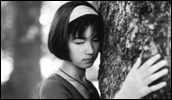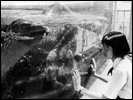August in the Water
- Year
- 1995
- Original title
- Mizu no naka no Hachigatsu
- Alternative title
- 水の中の八月
- Director
- Cast
- Running time
- 117 minutes
- Published
- 20 March 2001


by Jasper Sharp
There's a new girl at high school, Isuku (Komine), whose arrival as a high diving champion creates quite a splash. Her appearance coincides with a double meteorite strike in the forest outside the town, which inexplicably acts as a catalyst for a drought and a local epidemic which causes ones inner organs to turn to stone.
Taking in the whole spectrum of pre-millennial new age phenomena, the bizarre August in the Water (whose English language release title is a direct translation of the Japanese, though is not to be confused with Yoichiro Takahashi's identically titled Mizu no Naka no Hachigatsu, a 1998 coming of age drama which did the Festival circuit under the English language title of Fishes in August) is a bit of a mixed bag. Thematically, it's a real inspiration. The X-Files notwithstanding, this sort of imaginative pseudo-scientific fantasy stands fairly uniquely amongst contemporary cinematic output. Visually the film is also a wonder, with impressive use of natural lighting in the bright exteriors, and beautifully composed Zen-like static shots of the assorted esoteric ephemera alternating with rapid multiple-angle edits and abstracted close-ups of the natural phenomena.
It all marks rather a change of pace for Sogo Ishii, perhaps best known in Japan for his anarchic fast-paced action films from the early 80s, with their screaming soundtracks and lightning-fast edits. After almost a decade away from commercial features, which aside from a Japanese-produced live concert film of the German industrial band Einstuerzende Neubauten (½ Mensch, 1986) was spent either making pop promos or adverts, he returned in 1993 with the thriller Angel Dust, a far more studied, sober approach to film making than his frenetic earlier work such as Crazy Thunder Road (Kuruizaki Sandaa Rodo, 1980) and Burst City (Bakuretsu Toshi, 1982). This conscious shift in cinematic gear also marks out August in the Water, whose hallucinogenic ambiance was hinted at a few years earlier by his mesmeric The Master of Shiatsu (Shiatsu Oja, 1989), an inventive 12-minute short made, according to the director, for "therapeutic reasons".
Ishii's almost transcendental approach to a filmmaking in which he claims that the images come from within himself, apparently devoid of any outside cinematic influence, has certainly here resulted in a seductively distinct work. In this case however, the focus on aesthetics does come at the cost of the plot. August in the Water suffers from trying to fit in too much, lurching from one idea to the next (Gaia theory, Chaos theory, whatever) in order to cram in as much New Age imagery as the running time will allow.
Be it conversations with squeaking dolphins or the clumps of mushrooms surrounding the meteor which glow lysergically with an ultraviolet hue, drama takes a firm backseat to the dream logic narrative and the result is a film that will seem either detached and slow moving or hypnotically beautiful depending upon the perspective or state of consciousness of the individual viewer.